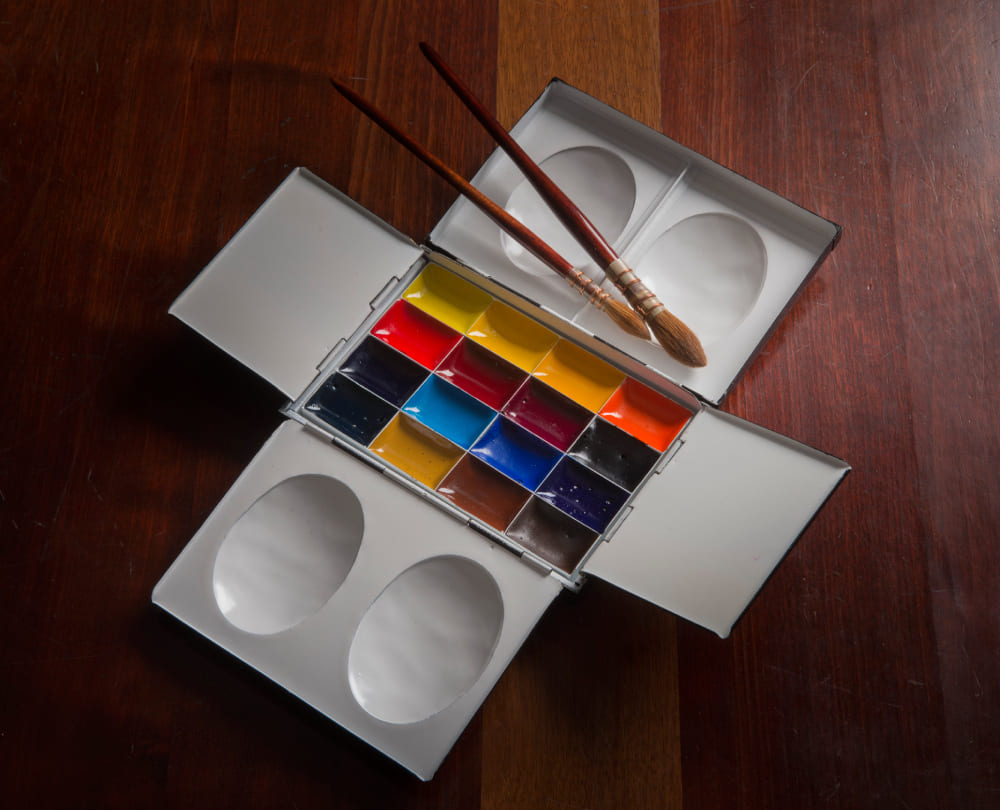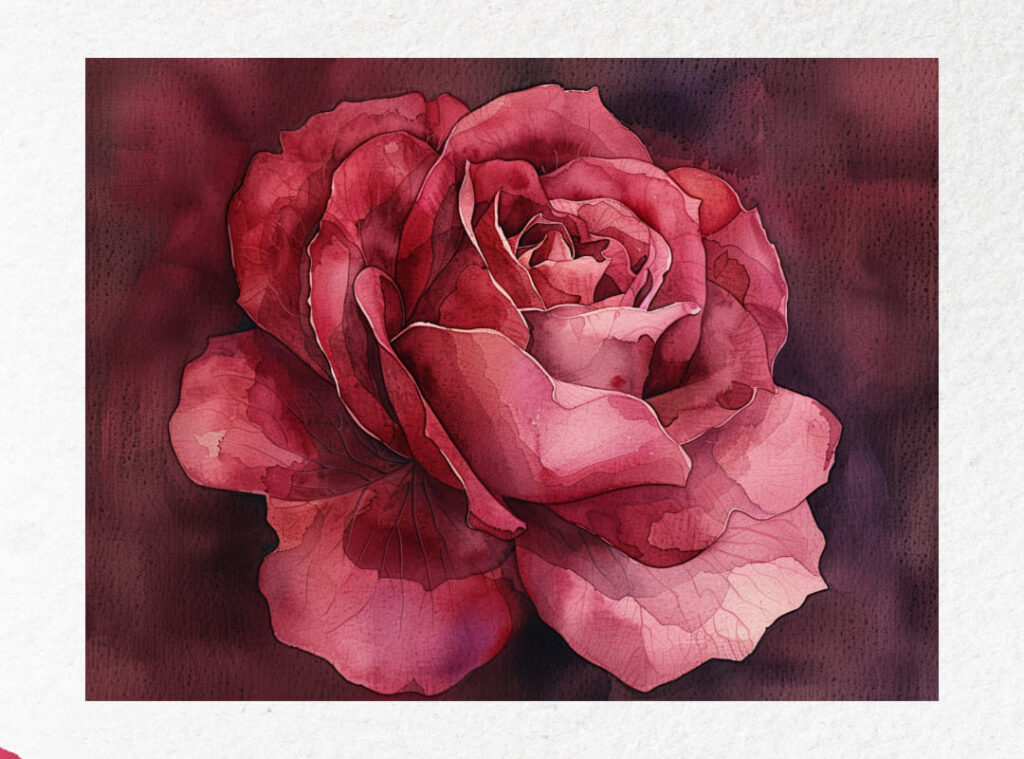Watercolour painting, with its pigmentation and transparency, offers artists an unparalleled means of expression.
Mastering this medium requires not only patience and practice, but also a deep understanding of certain essential processes.
Here are some key tips and techniques for learning watercolour and exploring its richness. This article is aimed at beginners who want to get started with watercolour painting on paper, as well as more experienced painters who want to improve their skills.

The materials to start with watercolour painting
Choosing your tools carefully is essential for getting off to a good start with watercolour painting. You need to select the most suitable ones based on your needs and preferences.
The colour palette
Start with a carefully curated selection of primary colours. Learning to mix your own shades from our range is key to creating a unique harmony. Explore our wide range of watercolour colours. You’ll find what you’re looking for among our rich and varied selection.

The choice of paper
Our Clairefontaine watercolour paper, with its various textures and weights, adapts to all your creative desires.
We recommend 300 g/m² Clairefontaine paper for better water control. We offer several types of grain for different effects and techniques. Smooth and fine papers can be used for all techniques as well as for precise artwork. Rough and clouded papers can be chosen to play with the paper’s pronounced texture.
The selection of brushes
Watercolour brushes provide the artist with the necessary control and flexibility for any technique. They can be made of natural hair for optimal absorption or synthetic fibers for better durability over time.
Round brushes are a versatile choice, allowing both precision and freer movements. Flat brushes are perfect for washes.
To make the most of these tools, it’s important to take good care of them and clean them properly.

The “wet-on-wet” technique
Steps to follow with this technique
The “wet-on-wet” technique is a fascinating way for artists to enjoy the fluidity and interaction of colours on paper.
- First, prepare your workspace by making sure you have enough water and paint on hand.
- Evenly wet the watercolour paper with a large brush or sponge to create a damp surface without excess water.
- Next, load your brush with diluted paint and carefully apply the watercolour to the wet paper.
- Watch the paint spread and blend with the water, creating unique and often unpredictable effects.
- Allow it to dry completely before adding details or additional layers.
The advantages of “wet-on-wet”
This technique is ideal for creating backgrounds, cloudy skies, or shadow and light effects. The trick is to let the water do the work, guiding the paint without trying to fully control the result.

The “wet-on-dry” technique
Steps to follow with this technique
The “wet-on-dry” technique gives artists more control over their work, making this method ideal for
fine details and textures.
- Start with completely dry watercolour paper.
- Choose a brush suitable for the details you wish to paint. Dip the brush in sufficiently diluted watercolour and apply it directly to the paper.
- Adjust the amount of water in the mixture to suit the pigmentation of the colour, creating effects ranging from translucent to opaque. Patience is the key.
- Allow each layer to dry completely before applying a new one, to maintain clean edges and colour purity.
The advantages of “wet-on-dry”
The advantage of this technique is that the colour stays exactly where you apply it, allowing you to accurately represent shapes and lines. This method is ideal for drawing objects, figures or anything that requires clear definition.
The “dry-on-wet” technique
Steps to follow with this technique
The “dry-on-wet” technique is an advanced technique that enables you to add texture and detail to
an already wet background.
- In this method, a wet primer is first applied to the paper, similar to the “wet-on-wet” method.
- Then, without waiting for the paper to dry, use a brush with less water and more paint to add elements to the still-wet background.
- Finding the right balance between paper moisture and paint consistency is the key to mastering the success of this technique. Experiment with different background drying times to see how they affect colour distribution and develop your own style.
The advantages of “dry-on-wet”
This watercolour technique allows you to spread paint easily, have more control than wet-on-wet and create interesting textural effects to highlight specific areas, for example.
The “dry-on-dry” technique
Steps to follow with this technique
The “dry-on-dry” technique is the most controlled, precise and perfect for adding finishing touches and details, or for working on small, complex areas.
- Make sure paper and brush are completely dry.
- For a darker colour, add slightly diluted paint to the brush and apply it exactly where you want it.
The advantages of “dry-on-dry”
This method allows you to be very precise when drawing elements, and is ideal for textures, details or brilliant highlights. “Dry-on-dry” requires a steady hand.
This approach can also be used when layering colours, adding depth and dimension to your artwork without the risk of mixing or blurring previous layers.
Advanced techniques for mastering water-based painting
Scraping and texturing
Our watercolours and paper allow you to use techniques like scraping to add dynamism and texture, revealing unexpected layers of colour.
Masking
Protect desired areas with masking fluid, designed to remove cleanly, preserving the whiteness and luminosity of the paper beneath. Each of these techniques has its own challenges and benefits.
Your ability to master beginner and advanced watercolour techniques depends on your understanding and judicious application of them. Practice regularly, be patient and don’t hesitate to experiment to discover new ways of expressing your creativity with watercolour.

Playing with colour and light
Transparency
The signature of Blockx watercolours lies in their ability to superimpose colours while retaining exceptional luminosity and clarity, offering depth and dimension to your work.
Contrast
The interplay between warm and cool colours is essential to guide the eye through the composition. A technique that our watercolours make intuitive.
White paper
By leaving certain areas of the paper unpainted, you can capture the purest light without resorting to opaque white. A practice where the quality of Clairefontaine paper makes all the difference.

Water control, essential to watercolour painting
Water control is essential to watercolour painting, as it determines transparency, fluidity and colour intensity.
Start by experimenting with different levels of humidity on your paper and brush to understand its impact on the paint. Using a brush with too much water on dry paper can dilute your colour excessively, while a brush that is too dry on damp paper may not diffuse as desired.

To master this technique, practice wash painting by varying the amount of water, then observe how this affects the luminosity and saturation of the colours.
Finally, don’t forget that drying time plays a crucial role. Learning watercolour means anticipating this factor for the creation of your next works.
Practice and patience: the keys to progress
Practice and patience are the cornerstones of learning watercolour, a medium that celebrates subtlety and unpredictability. Start by setting yourself regular painting sessions, however short, to explore different techniques and subjects.
The importance of repetition cannot be underestimated; each brushstroke on paper enriches your understanding of the behaviour of water and colour.
Allow yourself the freedom to experiment without fear of mistakes, as they are often a source of learning and innovation. Patience means recognizing that mastery comes with time and experience.

Celebrate your progress, whatever it may be, and remain open to the constant evolution of your style and skills. The beauty of watercolour lies in its learning process, where each work is a step towards a richer, more personal expression.
Watercolour is a delicate dance between technique, intuition and expression. With Blockx, plunge into the exploration of this fascinating medium, armed with the best materials and a desire to experiment. The key lies in regular practice and openness to discovery. Each brushstroke guides you towards mastery of watercolour, an enriching journey full of surprises.
To get started in watercolour, find a Blockx dealer near you. You’ll be able to take advantage of our wide range of colours and express your creativity and imagination.
Don’t hesitate to share your creations on Instagram with our community of enthusiasts. We’d love to share your work with you. It’s as simple as this:
- Post your photo
- Tag our account @blockxcolours
- Use the hastags #blockx and #blockxcolours



